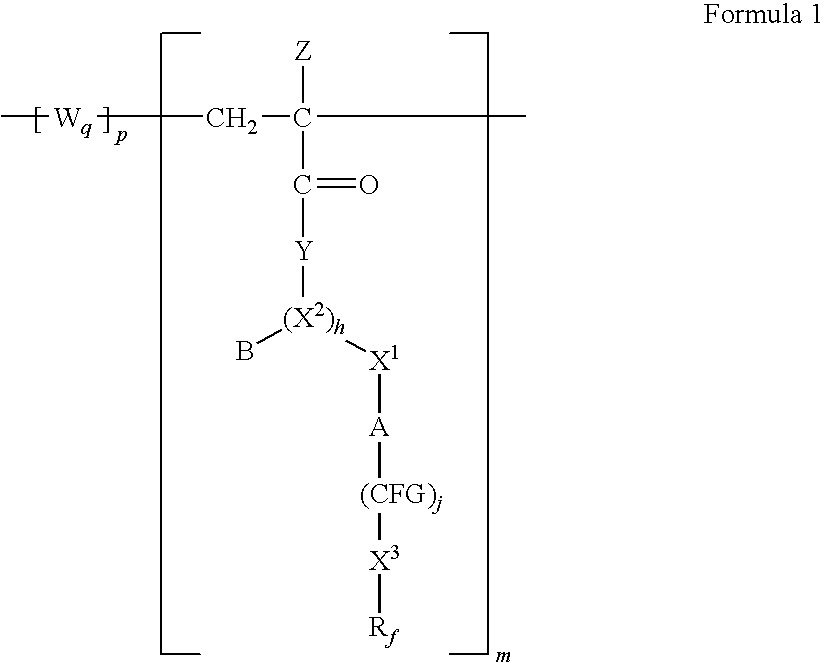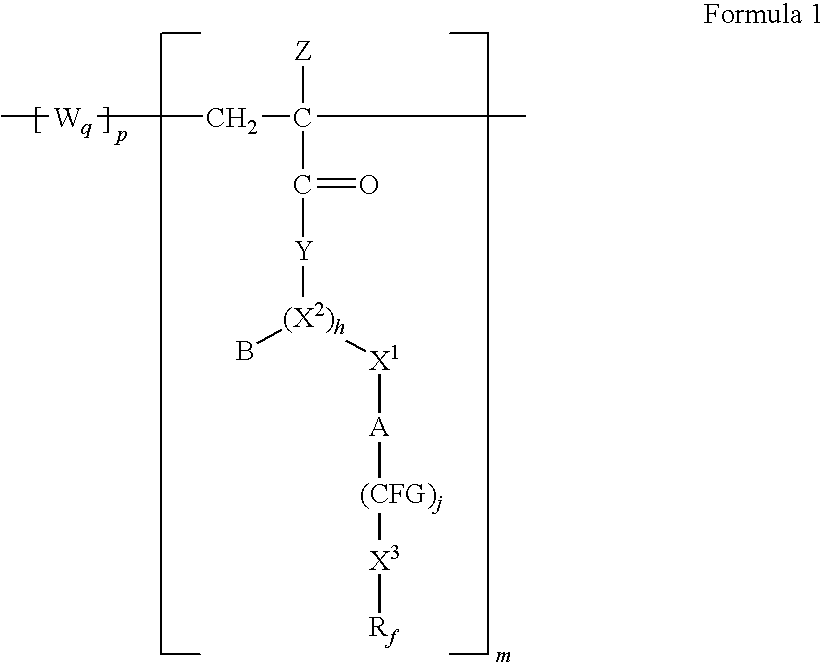Poly(METH)acrylamides and poly(METH)acrylates containing fluorinated amide
a technology of poly(meth)acrylamide and acrylamide, which is applied in the direction of textiles and paper, synthetic resin layered products, embroideries, etc., can solve the problems of shortening the chain of perfluoroalkyls that have traditionally not been successful commercially
- Summary
- Abstract
- Description
- Claims
- Application Information
AI Technical Summary
Benefits of technology
Problems solved by technology
Method used
Image
Examples
example 1
[0105]A 50-mL flask was charged with methyl 2,2,3,3-tetrahydroperfluorononanoate (9.0 g, prepared according to the procedure in U.S. Pat. No. 6,054,615) and 1,3-diamino-2-propanol (1.0 g). The resulting mixture was allowed to stir at 140° C. for 8 h. The reaction mixture solidified after being cooled to room temperature and dried on full vacuum for 8 h to give a solid (8.95 g). The product was N,N′-bis(2,2,3,3-tetrahydroperfluorononanoyl)-1,3-diamino-2-propanol as shown by the following analyses. H NMR (CDCl3) 2.52 (m, 9H), 3.36 (m, 4H), 3.80 (quintet, J=5 Hz, 1H), 6.36 (br s, 2H) ppm. F NMR −81.2 (tt, J=10, 3 Hz, 6F), −114.9 (m, 4F), −122.3 (m, 4F), −123.3 (m, 4F), −123.9 (m, 4F), −126.5 (m, 4F) ppm. For HNMR and FNMR for this and all examples herein, ppm indicates one part per one million parts in frequency shift.
[0106]A 25-mL flask was charged with N,N′-bis(2,2,3,3-tetrahydroperfluorononanoyl)-1,3-diamino-2-propanol (6.0 g.) prepared according to the above procedure, triethylamin...
example 2
[0109]A 100-mL bottle was charged with diethylenetriamine (6.64 g) and 52.6 g of methyl 2,2,3,3-tetrahydroperfluorononanoate (prepared according a procedure from U.S. Pat. No. 6,054,615). The resulting mixture was heated to 120° C. for 20 h. The reaction mixture was dried on vacuum at 70° C. for 2 h to give a solid (54 g). The product is 1,7-bis(2,2,3,3-tetrahydroperfluorononanoyl)-1,4,7-triazaheptane as shown by the following analyses. H NMR (CDCl3): 1.66 (br s, 1H), 2.51 (m, 8H), 2.78 (t, J=6 Hz, 4H), 3.35 (q, J=6 Hz, 4H), 6.20 (br s, 2H) ppm. F NMR (CDCl3): −81.3 (tt, J=10, 3 Hz, 6F), −115.1 (m, 4F), −122.4 (m, 4F), −123.4 (m, 4F), −124.0 (m, 4F), −126.6 (m, 4F) ppm.
[0110]A 100-mL flask was charged with 1,7-bis(2,2,3,3-tetrahydroperfluorononanoyl)-1,4,7-triazaheptane (15.7 g), triethylamine (2.49 g), and tetrahydrofuran (22 mL). Methacryloyl chloride (2.58 g dissolved in 7 mL of tetrahydrofuran) was added drop wise to the above mixture at about 10° C. The mixture was stirred at r...
example 3
[0113]A 25-mL bottle was charged with 1,3-diamino-2-propanol (0.61 g) and tetrahydrofuran (4 mL). Ethyl 3,3,4,4-tetrahydroperfluorooctanoate (5.0 g), (prepared according a procedure from U.S. Pat. No. 6,376,705), in tetrahydrofuran (2 mL) was added drop wise at about 10° C. The resulting mixture was allowed to stir for 15 h at room temperature. The reaction mixture was concentrated and dried on vacuum to give 5.0 g of solid. The product is N,N′-bis(3,3,4,4-tetrahydroperfluorooctanoyl)-1,3-diamino-2-propanol as show by the following analyses. H NMR (CDCl3) 1.53 (br s, 1H), 2.41 (m, 8H), 3.45 (m, 4H), 3.97 (Quintet, J=5 Hz, 1H), 6.99 (br. s, 2H) ppm. F NMR −81.5 (tt, J=10, 3 Hz, 6F), −107.1 (m, 4F), −115.1 (m, 4F), −124.7 (m, 4F), −126.4 (m, 4F) ppm.
[0114]A 50-mL flask was charged with N,N′-bis(3,3,4,4-tetrahydroperfluorooctanoyl)-1,3-diamino-2-propanol (4.8 g) prepared according to the above procedure, triethylamine (0.80 g), and tetrahydrofuran (20 mL). Methacryloyl chloride (0.82 g...
PUM
| Property | Measurement | Unit |
|---|---|---|
| temperature | aaaaa | aaaaa |
| temperature | aaaaa | aaaaa |
| temperature | aaaaa | aaaaa |
Abstract
Description
Claims
Application Information
 Login to View More
Login to View More - R&D
- Intellectual Property
- Life Sciences
- Materials
- Tech Scout
- Unparalleled Data Quality
- Higher Quality Content
- 60% Fewer Hallucinations
Browse by: Latest US Patents, China's latest patents, Technical Efficacy Thesaurus, Application Domain, Technology Topic, Popular Technical Reports.
© 2025 PatSnap. All rights reserved.Legal|Privacy policy|Modern Slavery Act Transparency Statement|Sitemap|About US| Contact US: help@patsnap.com



